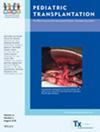优化小儿肝移植手术:评估供体年龄和移植物类型对患者存活结果的影响
IF 1.2
4区 医学
Q3 PEDIATRICS
引用次数: 0
摘要
背景我们研究了供体年龄和移植物类型对小儿肝移植结果的综合影响,旨在为战略性地利用这些供体和移植物选择提供见解。方法我们利用一个全国性数据库对0-2岁(N = 2714)和3-17岁(N = 2263)的小儿受者进行了回顾性分析。这些受者根据供体年龄(≥40 岁 vs <40 岁)和移植物类型进行分类。采用 Kaplan-Meier 模型和 Cox 比例危险模型对生存结果进行分析,然后进行意向治疗 (ITT) 分析,以检查患者的总体生存情况。这种差异在年轻受者(0-2 岁与 3-17 岁)中更为明显。尽管有这一发现,但 ITT 存活率分析表明,供体年龄和移植物类型对存活率并无影响,但 0-2 岁受者的存活率因年轻的活体供体移植物而有所提高。要改善等待名单上的死亡率,需要许多移植中心具备统一的外科专业知识,提供技术变异移植物(TVG)选择,并摆脱只为儿科受者寻求 "最佳 "移植物的保守心态。本文章由计算机程序翻译,如有差异,请以英文原文为准。
Optimizing pediatric liver transplantation: Evaluating the impact of donor age and graft type on patient survival outcome
BackgroundWe examined the combined effects of donor age and graft type on pediatric liver transplantation outcomes with an aim to offer insights into the strategic utilization of these donor and graft options.MethodsA retrospective analysis was conducted using a national database on 0–2‐year‐old (N = 2714) and 3–17‐year‐old (N = 2263) pediatric recipients. These recipients were categorized based on donor age (≥40 vs <40 years) and graft type. Survival outcomes were analyzed using the Kaplan–Meier and Cox proportional hazards models, followed by an intention‐to‐treat (ITT) analysis to examine overall patient survival.ResultsLiving and younger donors generally resulted in better outcomes compared to deceased and older donors, respectively. This difference was more significant among younger recipients (0–2 years compared to 3–17 years). Despite this finding, ITT survival analysis showed that donor age and graft type did not impact survival with the exception of 0–2‐year‐old recipients who had an improved survival with a younger living donor graft.ConclusionsTimely transplantation has the largest impact on survival in pediatric recipients. Improving waitlist mortality requires uniform surgical expertise at many transplant centers to provide technical variant graft (TVG) options and shed the conservative mindset of seeking only the “best” graft for pediatric recipients.
求助全文
通过发布文献求助,成功后即可免费获取论文全文。
去求助
来源期刊

Pediatric Transplantation
医学-小儿科
CiteScore
2.90
自引率
15.40%
发文量
216
审稿时长
3-8 weeks
期刊介绍:
The aim of Pediatric Transplantation is to publish original articles of the highest quality on clinical experience and basic research in transplantation of tissues and solid organs in infants, children and adolescents. The journal seeks to disseminate the latest information widely to all individuals involved in kidney, liver, heart, lung, intestine and stem cell (bone-marrow) transplantation. In addition, the journal publishes focused reviews on topics relevant to pediatric transplantation as well as timely editorial comment on controversial issues.
 求助内容:
求助内容: 应助结果提醒方式:
应助结果提醒方式:


